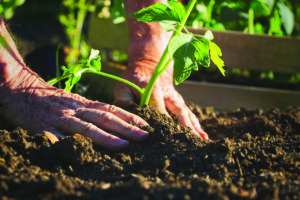
Tomatoes are among the many vegetables that can be planted right now.
It’s hard to believe May is already here, and summer is creeping up on us.
It’s time to plant outdoors! And it’s about time to start watering more, and moving around houseplants.
We’re here to help you navigate the heated transition into warmer weather, no matter what type of plants you enjoy.
In the Garden
Once temperatures really warm up, weeds and invasive plants can quickly multiply, so it’s important to stay ahead of them as much as you can.
The longer weeds are allowed to grow and spread, the more nutrients they’re taking from your flowers and vegetables.
When readying to plant, I recommend keeping Espoma’s organic Bio-Tone on hand. What’s Bio-Tone? It’s an awesome fertilizer consisting of vital plant nutrients, bacteria, and fungi (micorrhizae).
It helps immensely in minimizing transplant loss, helping young plants establish strong root systems, encouraging nutrient intake, and preventing disease. Additionally, it aids in soil aeration and water retention.
Add the Bio-Tone to the bottom of your newly dug holes before planting. Make sure the roots of your plant are coming in direct contact with the Bio-Tone. Now your plants are set up for success this gardening season!
What’s better than going out to your garden to harvest what you need for your next meal? You have the power to make your garden your grocery store. Consider planting vegetables and herbs! If you’re worried you don’t have enough space, you can easily grow veggies and herbs in containers. Among the many vegetables that can be planted right now include lettuce, tomatoes and spinach.
In addition to veggies and herbs, right now is the prime time to plant summer bulbs. Dahlias, cannas, calla lilies, and elephant ears are great examples of summer bulbs that can really add some “wow” to your yard this summer.
If you have any perennial or annual vines, or top-heavy varieties of plants such as peonies, don’t forget to set up trellises or supports to make sure they have something to grow with or against.
When it comes to pruning, plants that are coming down from their peak season will likely need it.
Pruning prevents plants from wasting energy on producing seed or from sending energy to parts of the plant that are already on their way out. Pansies, primroses, azaleas, roses, and spring bulbs can be deadheaded after they’re done blooming.
Boxwoods can be thinned out to promote more air circulation and sunlight to the interior.
Whether you love planting in the garden, keeping houseplants, or both, you should definitely consider decorating outdoors with some hanging baskets. They add gorgeous pops of color to any porch or entryway.
In the House
It’s about time to start thinking about moving your houseplants around, and even moving some outside. As temperatures are warming up, the sun will be stronger and shine longer. Some houseplants may need to be moved further away from windows to avoid scalding or sunburn.
However, be careful not to place plants in immediate proximity to air conditioners as the cold air will likely shock your plants — and we definitely don’t want that.
Consider opening windows in the morning or evening — when it’s not quite as hot — to provide some natural air circulation for them. In nature, the plants would receive air circulation from wind in their normal environments. It’s important to attempt to recreate those conditions every so often if you want to see your houseplants thrive.
If you’re thinking about moving some of your plants outside, only do so once temperatures are averaging at least 60 degrees every night.
Again, to avoid scalding or sunburn, consider placing them in a spot where they can receive bright, indirect light.
Most houseplants are tropical dwellers of rainforests and jungles, meaning they grow under the cover of large trees. So, placing them in bright, direct sunlight risks scalding them. More desert dwelling plants like succulents are much bigger fans of direct sun.
Heat also means that water will evaporate quicker, so you’ll likely need to water more often than you have been throughout the winter and spring.
Consider getting a moisture meter or gauge so that it’s easier to understand when your plants need watering. Remember, only water when the top inch of soil is dry.
Try not to wait until your plant is shriveling to water.
An easy way to tell if your plant needs water is by simply picking up the pot!
When you learn the weight difference and feeling of when a pot is dry versus when it’s been watered, it will make it much easier to know when to water.
Do not water with cold water. I know it’s tempting to feel like your plants might want to cool off, but
I promise if you, watering with ice cold water will shock the plants.
If your plants are pushing new growth, think about fertilizing them. This will encourage stronger, more robust growth. We recommend Espoma’s organic Indoor — simply add a half-cap of indoor plant food liquid per quart of water and water your plants.
Thoroughly drench the soil of the plant. For the best results repeat every two to four weeks throughout the growing season.
Moisture meters and indoor plant fertilizer can be found in our barn and greenhouse.
Happy May, happy Mother’s Day, and happy gardening!
(Editor’s Note: Ken Morgan is the owner of Robin’s Nest Floral and Garden Center in Easton, Md.)



